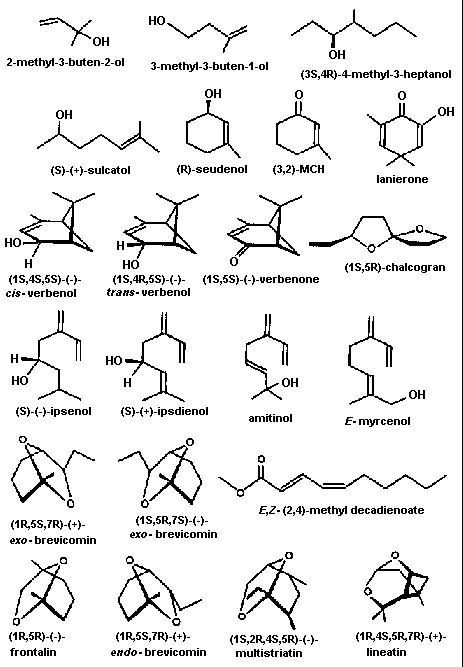5.5 PLANT COMPOUNDS AS PRECURSORS OF SEMIOCHEMICALS
Bark beetle pheromones used in aggregation and for avoidance of
competition consist of many varied structures (Fig. 5). Many of the
same pheromonal compounds are used by species in the same genus,
such as ipsenol, ipsdienol, and cis-verbenol in the genus Ips, or
exo-brevicomin, frontalin, trans-verbenol and verbenone in the
genus Dendroctonus (see Borden, 1982; Birch, 1984; Byers, 1989a).
Some compounds such as cis- and trans-verbenol may be found in Ips
(Scolytinae) as well as Dendroctonus and Tomicus (Hylesininae).
However, cis-verbenol has so far only been proven as an aggregation
pheromone component for species in the subfamily Scolytinae,
whereas trans-verbenol has semiochemical activity only in the
subfamily Hylesininae (Fig. 5).

Fig. 5. Pheromone components of bark beetles. Key: aggregation
component (a), inhibitor of aggregation (i). Row 1: 2-methyl-3-
buten-2-ol (a, I. typographus); 3-methyl-3-buten-1-ol (a, I.
cembrae), 4-methyl-3-heptanol (a, S. multistriatus). Row 2:
sulcatol (a, G. sulcatus, G. retusus); seudenol (D. pseudotsugae,
D. rufipennis, D. simplex); MCH (i, D. pseudotsugae); lanierone (a,
I. pini). Row 3: cis-verbenol (a, I. paraconfusus, I. typographus,
I. calligraphus); trans-verbenol (a, D. ponderosae, T. minor; i, D.
brevicomis); verbenone (i, Dendroctonus); chalcogran (a,
Pityogenes). Row 4: ipsenol (a, Pityokteines curvidens, and many
Ips: e.g. I. paraconfusus, I. grandicollis), ipsdienol (a, many
Ips, e.g. I. paraconfusus, I. duplicatus, I. pini, I. calligraphus,
I. avulsus); amitinol (a, I. amitinus); E-myrcenol (a, I.
duplicatus). Row 5: (+)-exo-brevicomin (a, D. brevicomis,
Dryocoetes); (-)-exo-brevicomin (a, Dryocoetes); methyl
decadienoate (P. chalcographus). Row 6: frontalin (a, many
Dendroctonus); endo-brevicomin (i, D. frontalis); multistriatin (a,
S. multistriatus); lineatin (a, T. lineatum). References to above
pheromones are in reviews by Borden (1982) and Byers (1989a), and
the following (Bakke, 1975; Baker et al., 1977; Lanne et al., 1987;
Borden et al., 1987; Byers et al., 1989b, 1990a, b; Teale et al.,
1991; Camacho et al., 1993).
Verbenone, although inhibiting
attraction response of most bark beetle species tested so far, is
produced in significant amounts only by species of Hylesininae
(usually males).
The base structure of ipsenol, ipsdienol, and E-myrcenol
resembles the plant monoterpene, myrcene; likewise, cis- and trans-
verbenol as well as verbenone resemble alpha-pinene (Figs. 4 and 5).
These structural similarities support the hypothesis, considered
next, that in many cases bark beetles use plant compounds as
precursors for their pheromone components. This hypothesis also
seems logical in that a beetle would save energy by reducing the
biosynthetic costs in the production of pheromones.

Byers, J.A. 1995. Host tree chemistry affecting colonization in bark
beetles, in R.T. Cardé and W.J. Bell (eds.). Chemical Ecology of
Insects 2. Chapman and Hall, New York, pp. 154-213.
